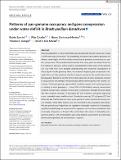| dc.contributor.author | Sancho, Rubén | |
| dc.contributor.author | Catalán, Pilar | |
| dc.contributor.author | Contreras‐Moreira, Bruno | |
| dc.contributor.author | Juenger, Thomas E | |
| dc.contributor.author | Des Marais, David L | |
| dc.date.accessioned | 2023-02-10T13:45:43Z | |
| dc.date.available | 2023-02-10T13:45:43Z | |
| dc.date.issued | 2022-10 | |
| dc.identifier.uri | https://hdl.handle.net/1721.1/148000 | |
| dc.description.abstract | Natural populations are characterized by abundant genetic diversity driven by a range of different types of mutation. The tractability of sequencing complete genomes has allowed new insights into the variable composition of genomes, summarized as a species pan-genome. These analyses demonstrate that many genes are absent from the first reference genomes, whose analysis dominated the initial years of the genomic era. Our field now turns towards understanding the functional consequence of these highly variable genomes. Here, we analysed weighted gene coexpression networks from leaf transcriptome data for drought response in the purple false brome Brachypodium distachyon and the differential expression of genes putatively involved in adaptation to this stressor. We specifically asked whether genes with variable "occupancy" in the pan-genome - genes which are either present in all studied genotypes or missing in some genotypes - show different distributions among coexpression modules. Coexpression analysis united genes expressed in drought-stressed plants into nine modules covering 72 hub genes (87 hub isoforms), and genes expressed under controlled water conditions into 13 modules, covering 190 hub genes (251 hub isoforms). We find that low occupancy pan-genes are under-represented among several modules, while other modules are over-enriched for low-occupancy pan-genes. We also provide new insight into the regulation of drought response in B. distachyon, specifically identifying one module with an apparent role in primary metabolism that is strongly responsive to drought. Our work shows the power of integrating pan-genomic analysis with transcriptomic data using factorial experiments to understand the functional genomics of environmental response. | en_US |
| dc.language.iso | en | |
| dc.publisher | Wiley | en_US |
| dc.relation.isversionof | 10.1111/mec.16661 | en_US |
| dc.rights | Creative Commons Attribution-NonCommercial-NoDerivs License | en_US |
| dc.rights.uri | http://creativecommons.org/licenses/by-nc-nd/4.0/ | en_US |
| dc.source | Wiley | en_US |
| dc.title | Patterns of pan-genome occupancy and gene coexpression under water-deficit in Brachypodium distachyon | en_US |
| dc.type | Article | en_US |
| dc.identifier.citation | Sancho, Rubén, Catalán, Pilar, Contreras‐Moreira, Bruno, Juenger, Thomas E and Des Marais, David L. 2022. "Patterns of pan-genome occupancy and gene coexpression under water-deficit in Brachypodium distachyon." Molecular Ecology, 31 (20). | |
| dc.contributor.department | Massachusetts Institute of Technology. Department of Civil and Environmental Engineering | en_US |
| dc.relation.journal | Molecular Ecology | en_US |
| dc.eprint.version | Final published version | en_US |
| dc.type.uri | http://purl.org/eprint/type/JournalArticle | en_US |
| eprint.status | http://purl.org/eprint/status/PeerReviewed | en_US |
| dc.date.updated | 2023-02-10T13:38:29Z | |
| dspace.orderedauthors | Sancho, R; Catalán, P; Contreras‐Moreira, B; Juenger, TE; Des Marais, DL | en_US |
| dspace.date.submission | 2023-02-10T13:38:32Z | |
| mit.journal.volume | 31 | en_US |
| mit.journal.issue | 20 | en_US |
| mit.license | PUBLISHER_CC | |
| mit.metadata.status | Authority Work and Publication Information Needed | en_US |
